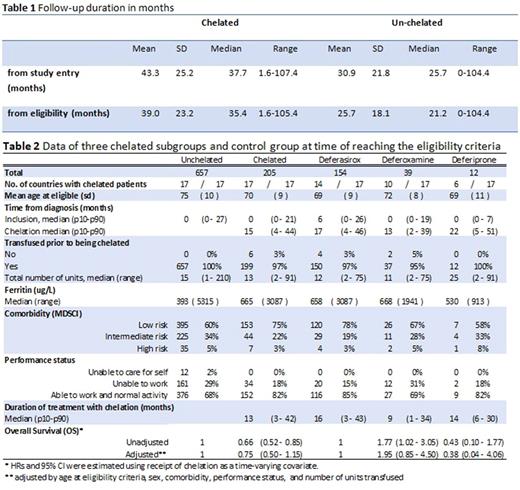Abstract
BackgroundIron overload/toxicity due to red blood cell transfusions (RBCT) is associated with morbidity and mortality in various patient groups, including patients with lower-risk myelodysplastic syndrome (LR-MDS). Many studies suggested improved overall survival (OS) after iron chelation therapy (ICT), but most studies suffer from methodological problems. In daily practice, many transfused LR-MDS patients receive ICT according to (inter)national guidelines to counteract the effects of RBCT. The value of ICT in LR-MDS remains unproven. The aim of this study is to assess the effect of ICT on OS in LR-MDS patients.
MethodsThe EUMDS registry, prospectively collects observational data on LR-MDS patients from 142 centers in 16 countries in Europe and Israel. Three iron chelators are available in Europe for treatment of secondary iron overload, but availability varies between countries. We first assessed the impact of treatment of the three iron chelators on OS. Secondly, we compared the chelated patients with a contemporary control group within the EUMDS registry. The control group consisted of patients who met the eligibility criteria for using ICT (≥15 RBC units, RBCT intensity of ≥1 RBC unit/month during a six-month period between visits, or serum ferritin ≥1000 µg/L), but who did not receive ICT. A Cox proportional hazards model was used, treating receipt of ICT as an time-varying variable. Finally, all transfused chelated and non-chelated patients were compared with a propensity-score matched model (3:1 nearest matching with replacement) in which more confounding factors could be added to Cox model in order to deal with confounding as adequately as possible.
ResultsThe EUMDS registry included 2205 patients as of July 2017. At this point, 205 patients received ICT. Table 1 shows the follow-up duration for all patients. Of the chelated patients, 154 received deferasirox as initial chelator, 39 deferoxamine, and 12 deferiprone. Nineteen patients switched from one chelator to another, but usually the treatment period of the 2nd chelator was short compared to the 1st chelator (data not shown). The median time on chelation for all 205 patients was 13 months (range 3-42). Patients receiving ICT were on average younger, had better performance scores and less comorbidities compared to the control group (table 2).
Comparison of three iron chelators The OS from the start of ICT for 154 patients treated with deferasirox is not significantly different compared to deferoxamine (n=39; p=0.058). The Hazard Ratio (HR) and 95% confidence intervals (CI) for OS (deferasirox as reference group) adjusted for age, sex, comorbidity, performance status, and cumulative number of RBCT for deferoxamine was 1.95 (0.85-4.50) and for deferiprone 0.38 (0.04-4.06) (Table 2).
Comparison with non-chelated control group The control group consisted of 657 non-chelated patients (table 2). The crude HR and 95% CI for OS for all chelated patients was 0.66 (0.52-0.85) (non-chelated group as reference). After adjusting for age, sex, comorbidity, performance status, RBCT intensity, cumulative number of RBCT, and IPSS-R, the HR was 0.75 (0.50-1.15). When the analysis was restricted to the patients treated with deferasirox, the crude HR was 0.61 (0.46-0.81) and the adjusted HR was 0.79 (0.51-1.22).
Propensity-matched model The chelated and non-chelated patients were matched for age, RBCT intensity, ferritin level, comorbidity, and performance status. 128 chelated patients and 223 controls could be matched, the overlap of propensity scores in both groups was good (data not shown). The crude HR and 95% CI for OS for the chelated group (non-chelated group as reference) was 0.77 (0.55-1.07). When correcting for age, sex, comorbidity, performance status, RBCT intensity, cumulative RBCT number, and IPSS-R, the HR was 0.62 (0.39-0.98). When we again restricted the analysis to deferasirox, the crude HR was 0.71 (0.48-1.06) and the adjusted HR was 0.58 (0.33-1.01).
Conclusion
OS of LR-MDS patients treated with ICT, was better compared to a large, control group and significantly better in a propensity-score matched model. In the absence of randomized, controlled trials proving the survival advantage of ICT, our large, prospective, observational study of clinical practice in Europe and Israel provides sound evidence of a beneficial effect of ICT on OS.
Fenaux: Novartis: Honoraria, Research Funding; Amgen: Honoraria, Research Funding; Janssen: Honoraria, Research Funding; Amgen: Honoraria, Research Funding; Celgene: Honoraria, Research Funding; Astex: Honoraria, Research Funding; Celgene: Honoraria, Research Funding; Astex: Honoraria, Research Funding; Janssen: Honoraria, Research Funding; Novartis: Honoraria, Research Funding. Sanz: Gamida Cell: Research Funding. skov-Holm: Celgene: Research Funding. Almeida: Alexion: Honoraria; Bristol Meyer Squibb: Honoraria; Servier: Consultancy; Celgene: Consultancy; Novartis: Consultancy. Germing: Novartis: Honoraria, Research Funding; Janssen: Honoraria; Celgene: Honoraria, Research Funding. Itzykson: Janssen: Research Funding; Novartis: Research Funding. Guerci-Bresler: BMS: Speakers Bureau; Incyte: Speakers Bureau; Pfizer: Speakers Bureau; Novartis: Speakers Bureau.
Author notes
Asterisk with author names denotes non-ASH members.


This feature is available to Subscribers Only
Sign In or Create an Account Close Modal